The Curious Alleys Of Borough High Street
The strange history lurking off London's oldest road.
You’ve probably been to the George Inn. But what’s down the many other historic alleys off Borough High Street? This week, I meandered down every single one of them — both in real life and in the archives — to uncover their centuries of history. I was expecting to discover Canterbury pilgrims and vanished coaching inns; I wasn’t expecting to find a forgotten tourist attraction and an antipodean cricket team…
That’s for the main section. First, a quick announcement and the history radar…
Look what we got ☝️ Over the weekend, Londonist: Time Machine was featured in Substack Reads, the official roundup of all that’s exciting here on the Substack platform. They highlighted our recent posts about the coloured-in Tudor map of London as an example of a creative newsletter. It made a huge difference. Over 300 new readers subscribed as a result. A big, big welcome to all of you. It’s great to have you here, and I hope you enjoy this, your first weekly newsletter…
History Radar
My weekly roundup of upcoming London history-themed events.
🕯🔔 BIG HISTORY NIGHT: Fancy a candlelit evening in Southwark Cathedral listening to some leading historians? The Big History Night In on 10 February has a very high-profile lineup of speakers, including Dr Tracy Borman, Dr Janina Ramirez, Greg Jenner and Lara Maiklem among others, covering a wide range of themes. The evening is in support of the charity Papyrus, who are dedicated to the prevention of suicide in young people.
📚🚶🏼LITERARY WALKS: Throughout March, Footprints of London will be putting on around 50 guided walks with literary themes. You might choose to retrace the route of Mrs Dalloway's day from the eponymous novel. Maybe you'd like to track down the historical sites from Wolf Hall. Or perhaps Rumpole of the Bailey is more your thing. All have dedicated walks, along with plenty of Dickens and Shakespeare action — non-fiction, too. Check out the programme here.
🧚🏽🪄THIN VEIL OF LONDON: A quick shout out to Minimum Labyrinth who, for over a decade, have been putting on delicious historical tours around London. On 27 February, there’s a chance to catch their magnificent “The Thin Veil of London”, which tours the Holborn area in search of places where the veil between the real and the magical is thin, a “vivid journey into the worlds of faery and science, madness and ecstasy”. OK, it’s a difficult one to describe but, trust me, it’s one of the best tours you’ll ever do.
💷 💳 FUTURE MONEY: I tend to focus on London’s history in this newsletter but, given that we’re in a time machine, a bit of forward vision is also apt. To that end, I’d like to point you towards an upcoming exhibition at the Bank of England Museum which will examine the future of money. “What’s the future for cash? What does a digital pound look like? Can the tooth fairy go cashless?” Answers to at least two of those questions will be found at the Bank from 28 February. Oh, and you’ll also be able to see the King Charles III bank notes before everyone else.
🪞🚪GORGEOUS GLASS: I had the pleasure last week of visiting Two Temple Place, the neo-Gothic wonder house on the Embankment. Its latest free exhibition shows off dozens of works of art made from glass — including stained glass, ornaments and, um, a glass fire extinguisher. It’s all very lovely, made all the more so by being showcased in one of London’s most beautiful historic homes. Here’s my review.
Now, on with the show…
The Curious Alleys of Borough High Street
I am a chasmophile; a lover of nooks and crannies. If I’m walking along a street and I spot an unexplored alleyway, then I explore it. The older parts of London are a chasmophile’s paradise. Alluringly named shortcuts like Hanging Sword Alley, French Ordinary Court and Bleeding Heart Yard cry out to be explored1.
Borough High Street in Southwark is as good as it gets for the chasmophile. This place is ancient. Two of the most important Roman roads — what would later be called Stane Street and Watling Street and, later still, Kennington Park Road (A3) and the Old Kent Road (A2) — converged near modern-day Borough tube station, whence commingled they pushed north to London Bridge. This bit, the approach to the bridge, is what we now call Borough High Street. It is pickled in 2000 years of history. It might even be London’s oldest road.
Borough High Street was perhaps best noted for its coaching inns. These served as starting points for horse-drawn journeys to the south. They also accommodated people arriving in London too late to cross the bridge, which was typically closed after sundown. A dozen such inns sprung up along the road during medieval times. Sadly, most were destroyed in a Great Fire — not the famous one of 1666, but one specific to the Borough just 10 years later.
They were rebuilt, and most lasted well into the Victorian era. But by the 1880s, their trade had been erased by a force more powerful than fire — the railways. The many hundreds of rooms offered by the inns could no longer find occupants, as fast rail travel replaced the coach. Most of the buildings were torn down. Only the George Inn now remains in something like its original form. The rest are remembered only in the names of the a dozen or so alleys, which branch off from the eastern side of Borough High Street.
In this week’s Londonist: Time Machine, I’m going to explore each one of these alleys, to discover pilgrims, prisons, pints… and an unexpected cricket team.
I’m aided in my explorations by a remarkable book I discovered a few years back. The Inns of Old Southwark (1888) was written in the final days of the old coaching inns. It contains many gorgeous illustrations of these lost taverns, some of which I’m reproducing here, for what looks like the first time on the internet2.
You can use these notes to guide your own explorations if you like. But I’ve also written them so you can virtually venture from your armchair. Let’s get going, starting at the northern end of the street…
1. King’s Head Yard
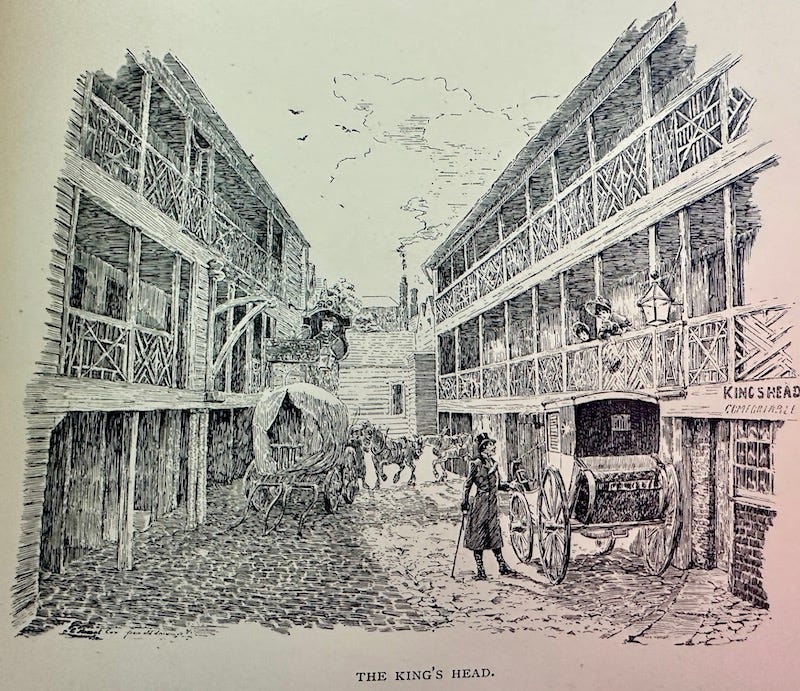
The menacing visage of Henry VIII hangs over the entrance to King’s Head Yard. Don’t let the old brute put you off. This is one of the most atmospheric — and yes, often the most uric — alleyways on the high street. Still, it’s nothing like as welcoming on the eye as in former days. As the illustration shows, the namesake King’s Head inn once filled the courtyard, with galleried buildings on either side. The whole lot was pulled down in 1885.
The King’s Head is still there — a Victorian rebuild — and it’s one of those charming, unreconstructed pubs that still has a carpet and a free-to-hire function room. Beyond, the alley curves gently and leads through to King’s College or, with a swift volte-face, curves round into our next alley…
2. White Hart Yard
The White Hart coaching inn vanished long ago, but it has left a mighty impression on popular culture. It was in the White Hart in 1450 that Jack Cade set up headquarters, before leading his rebellion into London proper. The incident is immortalised in Shakespeare’s Henry IV, Part 2. The inn also made an important appearance in Dickens. It was at the White Hart that Mr Pickwick first met Sam Weller, a character whose introduction elevated the monthly serialisation of Pickwick Papers to best-seller status and secured Dickens’s early fame.
The original pub was probably built in the reign of Richard II, whose symbol was a white hart. It was a mighty collection of buildings, comparable to a small village with rooms for 100 people. Like so much on Borough High Street, it burned down in the Great Fire of Southwark in 1676, but was soon rebuilt. The replacement lasted until 1889 — long enough for it to have been sketched by many artists.
The alley does still retain a drinking den in the stylish shape of the Coach House. This modern bar is affiliated with the George, which stands in its own neighbouring yard. Indeed, there’s now a little cut-through from White Hart Yard, a communication that never existed in ye olden days.
3. The George Inn
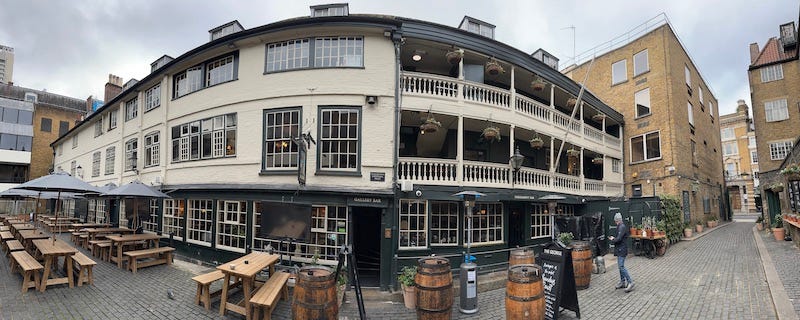
This next yard carries no nameplate, but it’s easily the most-visited of Borough High Street’s offshoots, for it contains the world-famous George Inn. This Grade I-listed building has stood since the 17th century, but its previous incarnations date back to medieval times. Dickens mentions it, Shakespeare almost certainly drank here. It’s one of London’s A-list pubs. (And was the scene of the very first historic drinks night for Londonist: Time Machine paid subscribers.)
The pub was named after St George and was, for a time, known as the George and Dragon. Confusingly, it once featured a pub sign bearing the countenance of George IV, but that’s long gone.
As you’ll have appreciated by now, Borough once contained many pubs of this ilk, with large courtyards for horse-drawn vehicles and galleried accommodation. George is the last man standing. There is much more to say about this fine pub, and I refer the interested reader to Pete Brown’s splendid biography of the place, called Shakespeare’s Local.
4. Talbot Yard
I have a very fond memory of joining a group of strangers in this alley, one early morning in 2013. Some were in medieval costume. Most clutched volumes of poetry. We were about to embark on a four-day hike to Canterbury, following the roads and footpaths that would have been known to Chaucer’s pilgrims (had they existed). In The Canterbury Tales, Chaucer has his motley band of storytellers set off from the Tabard Inn, which was a real hostelry that once stood right here in Talbot Yard. The original Tabard burned down in a disastrous fire of 1676. It was rebuilt as the Talbot, hence the current alley’s name. It was demolished in 1873 and nothing remains, although at least there’s a plaque.
Talbot Yard carries on to the east, offering a semi-obstructed view of the back of the George, before threading through the service roads of King’s College to join up with White Hart Yard and King’s Head Yard.
5. Queen’s Head Yard
We’ve had several kingly references, so now it’s time for a Queen. A pub of this name was first recorded on the site of this yard in 1587, and was previously known as the Crossed Keys. The name change may have occurred during the Reformation, when symbols of Papacy (such as St Peter’s keys) were hastily removed from pub signs in favour of something safer (not, as it turned out, that Queen’s heads were any safer in Henry VIII’s time).
The Queen’s Head was briefly owned by local boy John Harvard, before he toddled off to the New World to find posthumous fame in his namesake university. His inn is less-well remembered. Nothing down the surviving runt of an alleyway reminds us of its presence. That’s a pity because it played a key role in one of the most remarkable sporting events of the 19th century. In May 1868 a team of Aboriginal Australians came over to England to play a series of cricket matches at Lord’s. Indigenous Australians had visited London before, but not in this number and not for sporting purposes. The 13 men stayed at the Queen’s Head for the duration of their trip. The cricket-loving Mr Pickwick would surely have approved.
6. Kentish Buildings
Finally, we reach an alley (or trio of alleys) whose name does not have a direct pub connection. But it used to. This was once Christopher’s Alley (see map), named after the 16th century Christopher Inn… a descendant of which can still be found beside one entrance. The alley seems to have changed name to Kentish Buildings at the end of the 18th century, in tribute to the hop trade (a hallmark of Kent) which flourished in this part of Borough.
Kentish Buildings today is not much to look at, but it is the only alley on Borough High Street where you can still find a room at the inn. The Christopher runs a hostel from the surrounding buildings, while the southern prong of Kentish Buildings houses a new-build Premier Inn. Brash and modern the hotel might be, but it carries on the local accommodation trade that goes back hundreds if not thousands of years.
7. Nag’s Head Yard
This one’s so obscure it doesn’t even merit a label on OpenStreetMap, which usually treats thoroughness as an extreme sport. You won’t be surprised to learn that this is yet another alley named after a pub. Known as the Horse’s Head in ancient times, it became the Nag sometime in the 17th century.
The alley today does not look very promising. It’s clearly a service and parking yard for the Premier Inn. But look again. It has retained its cart-worn flagstones flanked by stone setts, probably from the Victorian era. Meanwhile, a tall brick wall to the back of the yard is of similar vintage. It may well have stood at the same time as the forgotten pub. Sadly, the yard is gated off in the middle, preventing further passage.
8. Newcomen Street (formerly Axe and Bottle Yard)
Newcomen Street is an actual street these days, rather than an alley, but you should still pop down it if only to see the King’s Arms pub. The royal coat of arms above the door is a remnant of Old London Bridge. It once adorned the old Stonegate — an arched entrance to the bridge. This was demolished in 1760, but the coat of arms was rescued and placed on the pub. Pop inside for a pint if you’re so inclined. Like the Old King’s Head, the pub has a lovely ‘old school’ vibe to it. According to the Inns of Old Southwark, a man called Richard Griffin died here in 1736 at the almost impossibly grand age of 116. His funeral featured 116 ancient pall-bearers.
You won’t find Newcomen Street on our map. Until the 19th century, this was Axe and Bottle Yard, named once again after a local tavern. The yard has been widened and knocked through to Snowfields, but it still retains a slight kink of old.
9. Mermaid Court
At the time of writing (Jan 2024), the entrance to Mermaid Court is enportalled with wraparound vinyl-art that couldn’t be more out of keeping with the alley’s antiquity. Mutton dressed as laminate. And yet its words are inspired by the area’s history:
Stories play,
They dance,
They sway,
On the walls of memories,
Dreams of present stay.
The artwork, by Farouk Agoro speaks of historical continuities and folk memories, and is inspired by local ‘ghost signs’, fading old adverts that linger on brick walls long after the demise of the businesses they promote. It’s the most notable aspect of Mermaid Court today, which is a largely featureless cut-through to the housing estates behind.
I can find precious little about the eponymous Mermaid Inn. It’s mentioned along with the King’s Arms in 1565, so is obviously ancient. It once rubbed up against the side of the Marshalsea Prison, before that moved a few alleyways south (see below).
10. Chapel Court
Chapel Court is one of the few alleys hereabouts that does not lead through to anywhere, unless you have business with the Diocese of Southwark, who have headquarters down this aptly named alley.
Otherwise, you might be lured in by the sight of this half-timbered building. How many centuries has that stood there? I don’t have a doctorate in medieval history, but I’m pretty sure that uPVC double-glazed windows were not the norm in those days. The door, too, looks suspiciously 1980s. What’s going on here?
Little can be found online about this strange Frankenstein’s monster of a building. It is not a listed structure and seems to be a modern pastiche (though using old timbers). Newspapers from 1986 advertise a “Pilgrims Medieval Banquet” on Chapel Court — a gastronomic tourist magnet which today would be called an “immersive Chaucerian experience”. I think we’re looking at its patched-up cackbastard remains.
Sadly, the alley’s chief attraction, the Blue Eyed Maid pub, closed a few years back and is now in a sorry state. Its closure is a loss to the area, but also scuppered my ‘12 Days of Christmas pub crawl’, which relied on this place for the ‘maids a milking’ stop. This was another ancient pub, and Chapel Court was once known as Blue Maid Alley.
11. Angel Place
We pass a further short, unnamed alley, entirely dominated by the Royal British Legion, and head into our final passage beside the John Harvard Library (spend 20 minutes reading a book in here, and you can claim you studied at Harvard).
Angel Place is perhaps the most interesting of all Borough’s alleys, for it’s down here we shall encounter the remains of the Marshalsea Prison. This notorious jail originally stood on Mermaid Court, but moved south a few metres in the early 19th century. It was mostly for debtors who, despite their bankruptcy, still had to pay fees for their lodgings. The most famous inmate was John Dickens, whose son you might have heard of. Charles Dickens visited his father here many times, and immortalised the jail in Little Dorrit (look out for the pavement plaques which recall that story). The Marshalsea closed in 1842 and was mostly demolished. However, Angel Place contains substantial remnants of its southern wall. You can even pass through the Marshalsea wall via an arch, into a pocket park beside St George the Martyr church — one small step for a chasmophile, one impossible leap for John Dickens.
At least to me. But I can totally understand if you don’t like dipping into dimly lit spaces that often smell a bit suspicious.
If someone reminds me, I’ll bring it along the next time we do an ‘historic drinks night’ for paying subscribers.
I hope you enjoyed our tour of Borough High Street’s alleys. That was the longest newsletter yet — and I had to leave quite a bit out! Do have a wander next time you’re in the area, and perhaps stop by in the George, the King’s Head or the King’s Arms. Feel free to leave a comment, or contact me any time on matt@londonist.com.
Next week: I just can’t help myself… we’re going to do another map. This time, every London location mentioned in Sherlock Holmes.


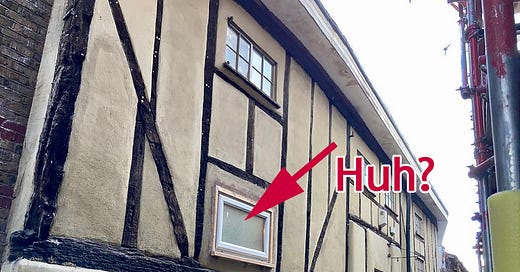



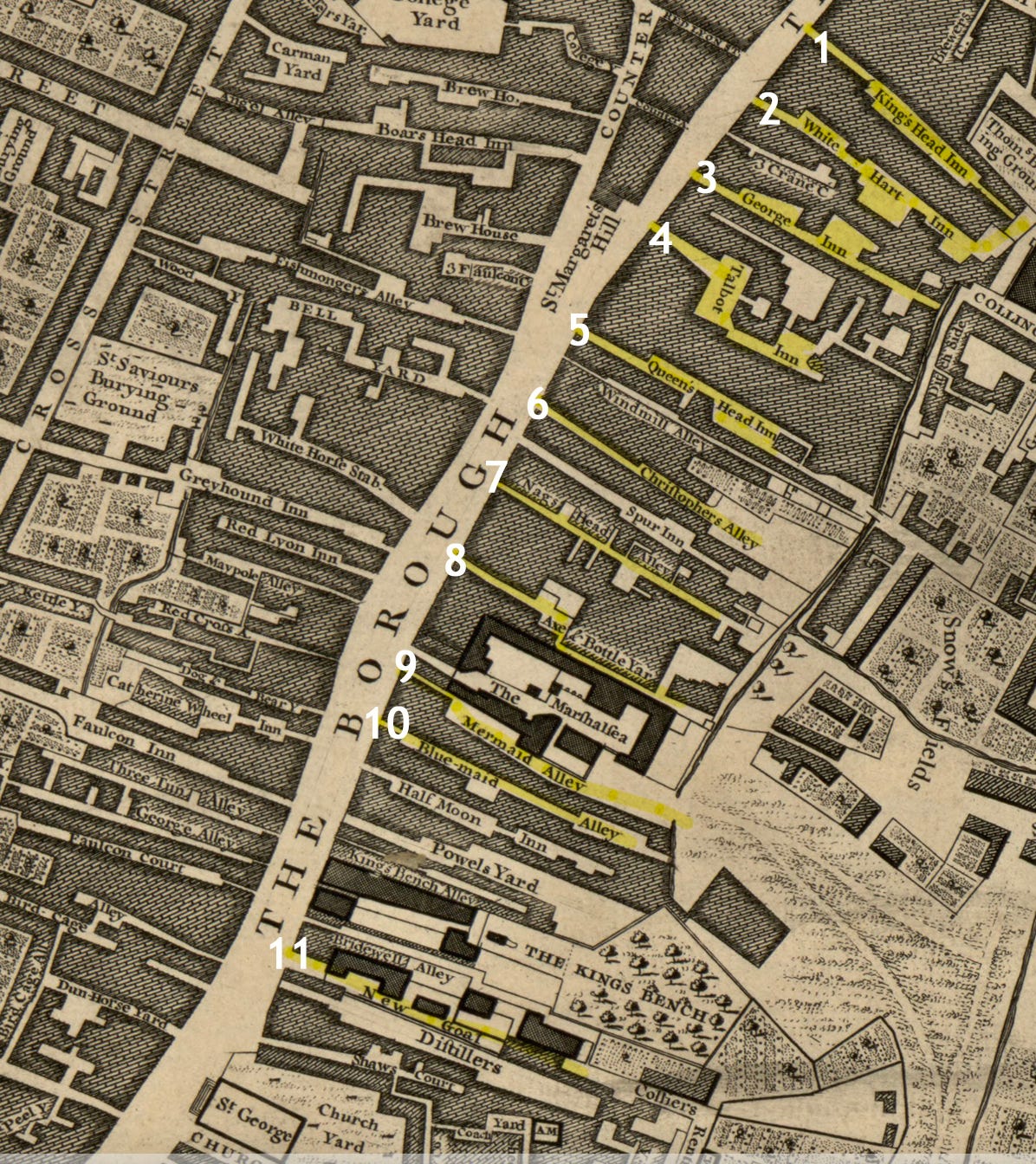
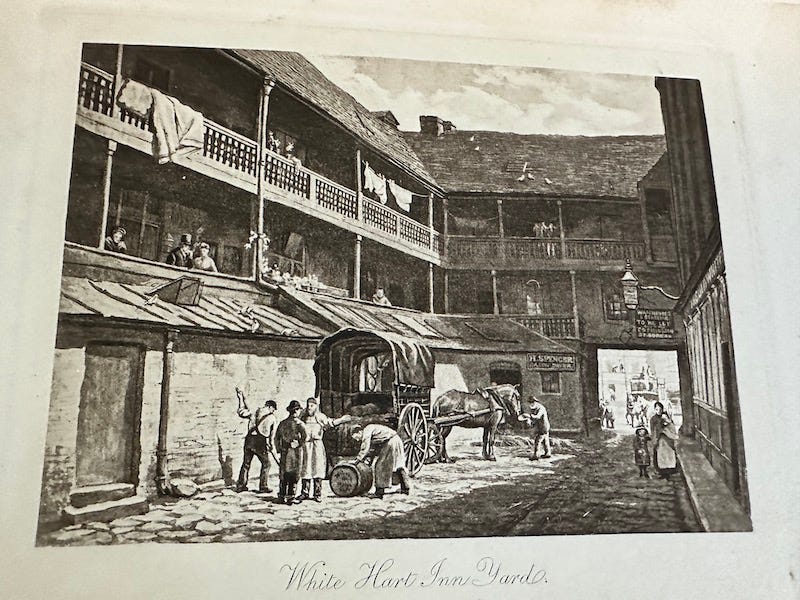
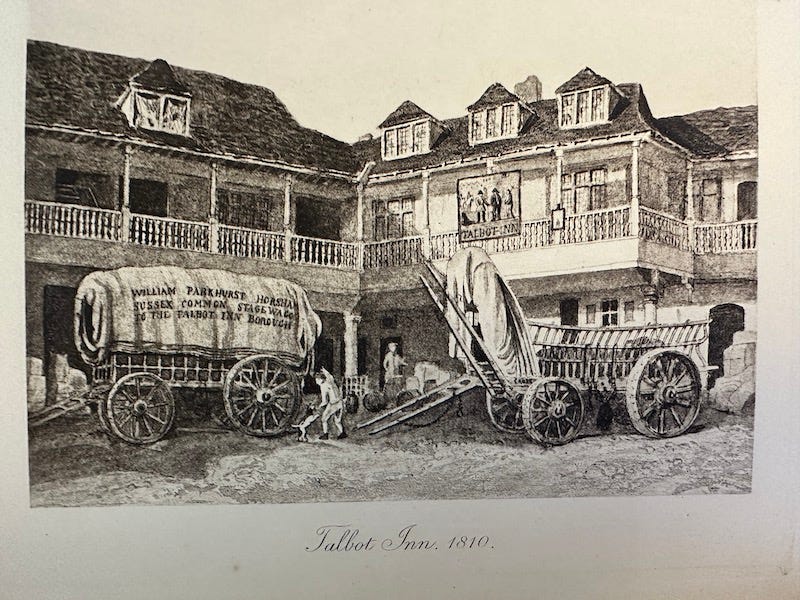
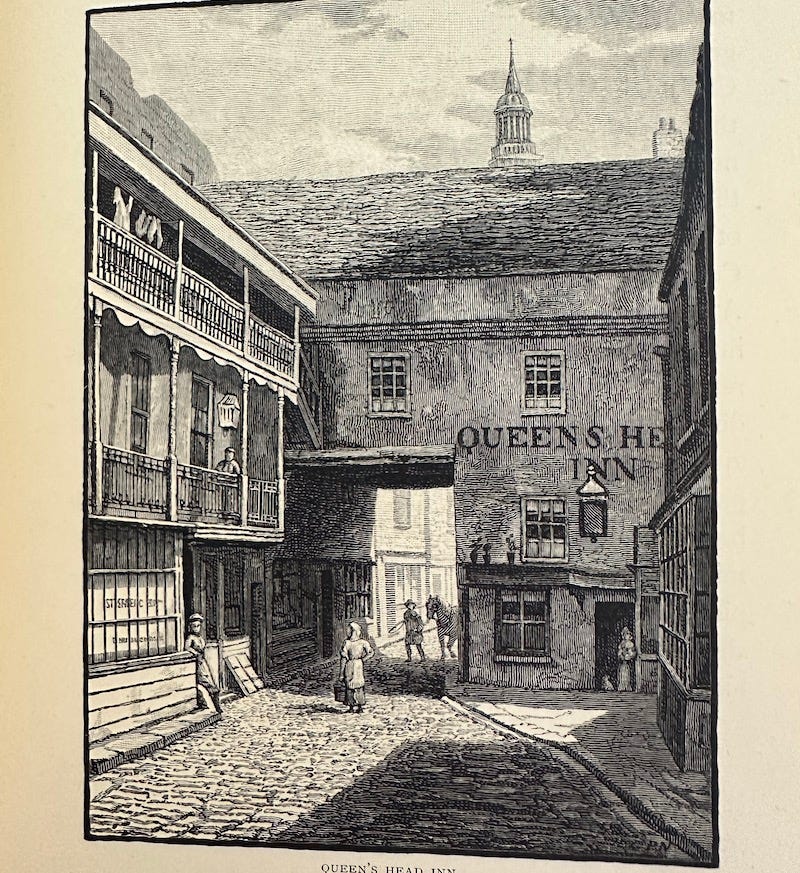
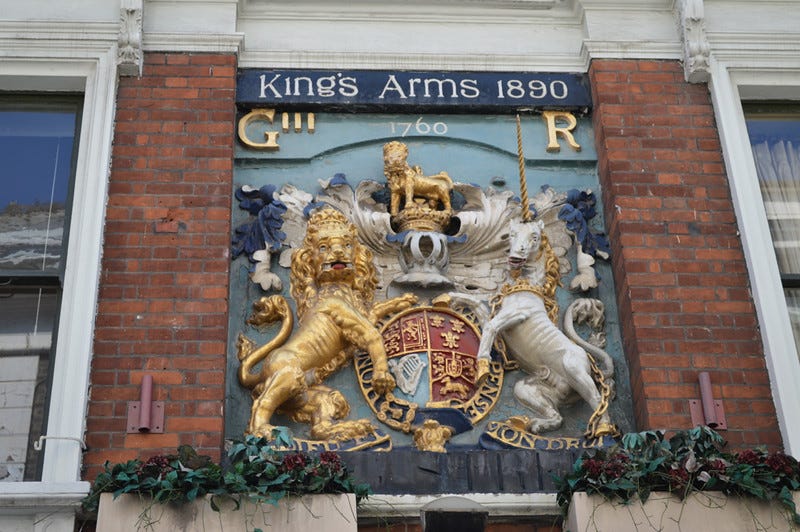
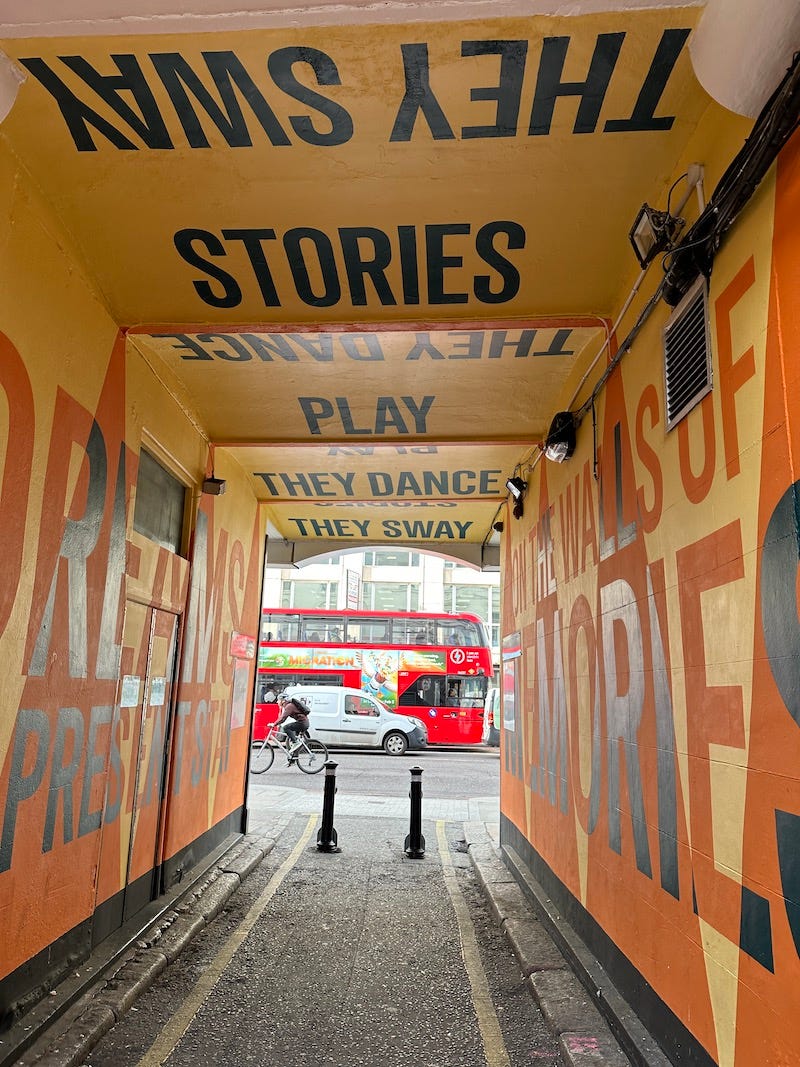

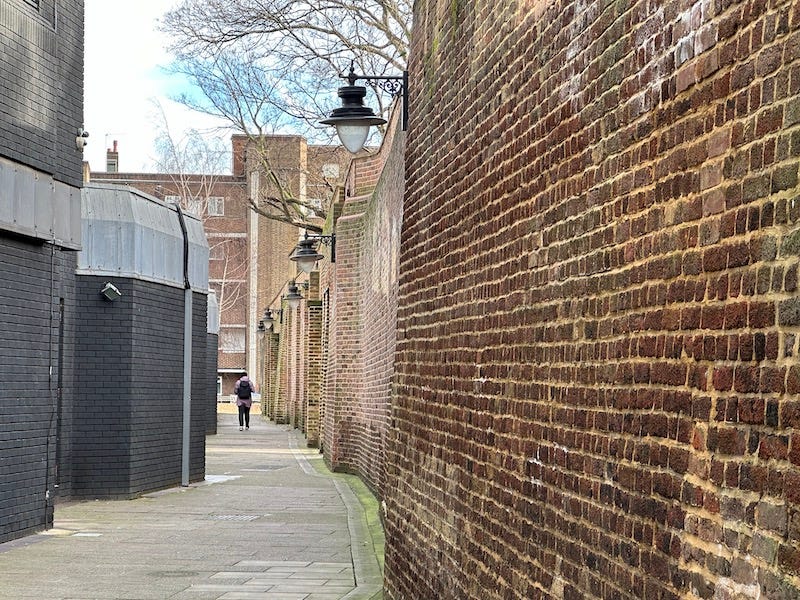
I’ve walked down Borough High Street so many times, casting a glance down the different alleys, but now they’ve got a whole new layer of meaning thanks to this. Extraordinary amount of research here - thank you!
And I LOVE chasmophile
Love an alleyway ,there's one in my town called Peter's Finger! I love a map too. Never get tired of looking at old maps. Thank you.